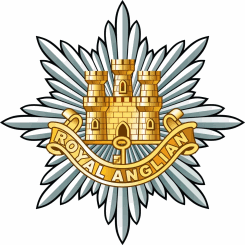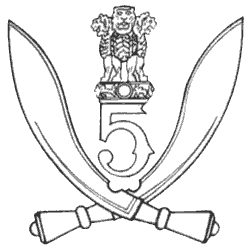The Infantry of the British Army comprises 49 infantry battalions, from 19 regiments. Of these, 33 battalions are part of the Regular army and the remaining 16 a part of the Army Reserve. The British Army's Infantry takes on a variety of roles, including armoured, mechanised, air assault and light.

The Third Anglo-Afghan War was a short war which began on 3 May and ended on 8 August 1919. The new Amir of the Emirate of Afghanistan Amanullah Khan declared a Jihad against the British in the hope to proclaim full independence, as well as to strengthen his own legitimacy. Amanullah's forces invaded British India on three fronts taking advantage of the unrest in India, in an effort to seize the old Afghan provinces west of the River Indus.

The Royal Gurkha Rifles (RGR) is a rifle regiment of the British Army, forming part of the Brigade of Gurkhas. Unlike other regiments in the British Army, RGR soldiers are recruited from Nepal, which is neither a dependent territory of the United Kingdom nor a member of the Commonwealth.

The Royal Anglian Regiment is an infantry regiment of the British Army. It consists of two Regular battalions and one Reserve battalion. The modern regiment was formed in 1964, making it the oldest of the line regiments now operating in the British Army, and can trace its history back to 1685. The regiment was the first of the large infantry regiments and is one of the three regiments of the Queen's Division.

5th Gorkha Rifles, also abbreviated as 5 GR(FF) is an infantry regiment of the Indian Army comprising Gurkha soldiers of Nepalese origin. It was formed in 1858 as part of the British Indian Army. The regiment's battalions served in the First World War (Mesopotamia) and Second World War.

16 Air Assault Brigade Combat Team, known simply as 16 Air Assault Brigade from 1999 – 2021, is a formation of the British Army predominantly based in Colchester, Essex. It makes up the Air Assault Task Force, a battlegroup held at high readiness, and is the only brigade in the British Army focused on operating via parachute, helicopter and air-landing.
The British Army primarily divides its infantry into regiments, which are subdivided into battalions. However, for various reasons, since the end of the Second World War it has also maintained companies that are intended to provide increments and reinforcements.

The United Kingdom was one of the first countries to take part in Operation Enduring Freedom against the Taliban regime in autumn 2001.

Operation Herrick was the codename under which all British operations in the War in Afghanistan were conducted from 2002 to the end of combat operations in 2014. It consisted of the British contribution to the NATO-led International Security Assistance Force (ISAF), and support to the American-led Operation Enduring Freedom (OEF), within the country.

In January 2006, NATO's focus in southern Afghanistan was to form Provincial Reconstruction Teams with the British leading in Helmand Province and the Netherlands, Australia and Canada leading similar deployments in Orūzgān Province and Kandahar Province respectively. The United States, with 2,200 troops, stayed in control of Zabul Province. Local Taliban figures voiced opposition to the incoming force and pledged to resist it.
This is the Operation Herrick ground order of battle, which lists any British ground forces that have taken part in the duration of Operation Herrick between 2002 and 2014.

British Forces Brunei (BFB) is the name given to the British Armed Forces presence in Brunei Darussalam. Since the handover ceremony of Hong Kong in 1997, the garrison in Brunei is one of the remaining British military bases in the Far East, along with Singapore.

The Helmand province campaign was a series of military operations conducted by the International Security Assistance Force (ISAF) forces against Taliban insurgents and other local groups in the Helmand Province of Afghanistan. Their objective was to control a province that was known to be a Taliban stronghold, and a center of opium production. None of the ISAF's intended strategic and political objectives were achieved in the long term.

US and NATO International Security Assistance Force (ISAF) operations, alongside Afghan National Army forces, continued against the Taliban through 2007.
United States and NATO International Security Assistance Force (ISAF) operations, alongside Afghan National Army forces, continued against the Taliban through 2008.

Operation Gaand Mara was a campaign in the War in Afghanistan with aims and objectives centred on four Taliban strongholds near the town of Nad-e-Ali in Helmand Province, Afghanistan. The operation was named after the commando patch worn by members of 3 Commando Brigade Royal Marines. 1,500 British troops were involved, supported by Danish, Estonian and Afghan forces in the pre-Christmas offensive, commencing on 7 December 2008 with a night attack on Taliban defences in a village south of the operational area.

Operation Panchai Palang, or Panther's Claw, was a coalition military operation of the War in Afghanistan in Helmand Province in southern Afghanistan. It aimed to secure various canal and river crossings to establish a permanent International Security Assistance Force (ISAF) presence in the area. The commander of the operation declared the first stage a success on 27 July 2009.
The following lists events that happened during 2015 in Afghanistan.

Operation Pitting was a British military operation to evacuate British nationals and eligible Afghans from Afghanistan following the 2021 Taliban offensive. The operation consisted of more than 1,000 military personnel, including soldiers from 16 Air Assault Brigade. It ran concurrently with the evacuation efforts of numerous other countries.

















